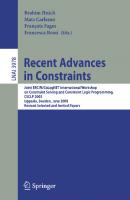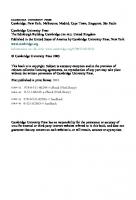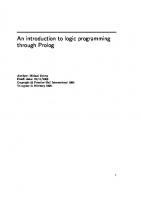Constraint Logic Programming. A Survey
174 35 711KB
English Pages [84] Year 1994
Recommend Papers

- Author / Uploaded
- Jaffar J.
- Maher M.J.
File loading please wait...
Citation preview
J. LOGIC PROGRAMMING: to appear
1
Constraint Logic Programming: A Survey
Joxan Jaffar and Michael J. Maher
⊳
Constraint Logic Programming (CLP) is a merger of two declarative paradigms: constraint solving and logic programming. Though a relatively new field, CLP has progressed in several quite different directions. In particular, the early fundamental concepts have been adapted to better serve in different areas of applications. In this survey of CLP, a primary goal is to give a systematic description of the major trends in terms of common fundamental concepts. The three main parts cover the theory, implementation issues and programming for applications.
⊲
1. Introduction
Constraint Logic Programming (CLP) began as a natural merger of two declarative paradigms: constraint solving and logic programming. This combination helps make CLP programs both expressive and flexible, and in some cases, more efficient than other kinds of programs. Though a relatively new field, CLP has progressed in several and quite different directions. In particular, the early fundamental concepts have been adapted to better serve in different areas of applications. In this survey of CLP, a primary goal is to give a systematic description of the major trends in terms of common fundamental concepts. Consider first an example program in order to identify some crucial CLP concepts. The program below defines the relation sumto(n, 1 + 2 + · · · + n) for natural numbers n.
sumto(0, 0). sumto(N, S) :- N >= 1, N = 1, N1 = N - 1, X1 = X - N, sum(N1, X1). Of concern to us here are constraints that, if added to the store, can be shown to become redundant as a result of future additions to the store. This notion of future redundancy was first described in [138]. Now if we execute the goal sum(N, X) using the second rule above, we obtain the subgoal
?- N >= 1, N1 = N - 1, X1 = X - N, sum(N1, X1). Continuing the execution, we now have two choices: choosing the first rule we obtain the new constraint N 1 = 0, and choosing the second rule we obtain the constraint N 1 ≥ 1 (among others). In each case the original constraint N ≥ 1 is made redundant. The main point of this example is that the constraint N ≥ 1 in the second rule should be implemented simply as a test, and not added to the constraint store. We hence define the new class of instructions solve no add xxx. This example shows that future redundant constraints do occur in CLP systems. However, one apparent difficulty with this special case is the problem of detecting its occurrence. We will mention relevant work on program analysis below. Meanwhile, we remark that experiments using CLP(ℛ) have shown that this special case leads to the most substantial efficiency gains compared to the other two kinds of special cases discussed in this section [188, 266]. Finally consider special case 3. Of concern here are constraints which are neither entailed by the store as in case 1 nor are eventually made redundant as in case 2, but which are required to be added to the store, and checked for consistency. What makes these constraints special is that after they have been added to the store (and
53
the store is recomputed into its new internal form), their variables appear in those parts of the store that are never again referred to. Consider the sum program once again. The following sequence of constraints arise from executing the goal sum(7, X): (1) X1 = X − 7 (2) X 1′ = (X − 7) − 6 (3) X 1′′ = ((X − 7) − 6) − 5 ··· ··· Upon encountering the second equation X 1′ = X 1 − 6 and simplifying into (2), note that the variable X 1 will never be referred to in future. Hence equation (1) can be deleted. Similarly, upon encountering the third equation X 1′′ = X 1′ − 5 and simplifying into (3), the variable X 1′ will never be referred to in future and so (2) can be deleted. In short, only one equation involving X need be stored at any point in the computation. We hence add the class of instructions of the form add and delete X which informs the solver that after considering the constraint associated to X, it may delete all structures associated to X. In CLP(ℛ), the corresponding instruction is addpf and delete n, X, the obvious variant of the previously described instruction addpf n, X. Compiling this sum example gives
(1)
(2)
(3)
···
init pf addpf solve no fail eq init pf addpf and delete solve no fail eq init pf addpf and delete solve no fail eq ···
-7 1, X X1 -6 1, X1 X1’ -5 1, X1’ X1’’
Note that a different set of instructions is required for the first equation from that required for the remaining equations. Hence the first iteration needs to be unrolled to produce the most efficient code. The main challenge for this special case is, as in special case 2, the detection of the special constraints. We now address this issue. 11.2.2. Techniques for CLP Program Analysis The kinds of program analysis required to utilize the specialized instructions include those techniques developed for Prolog, most prominently, detecting special cases of unification and deterministic predicates. Algorithms for such analysis have become familiar; see [73, 74] for example. See [98], for example, for a description of how to extend the general techniques of abstract interpretation applicable in LP to CLP. Our considerations above, however, require rather specific kinds of analyses. Detecting redundant variables and future redundant constraints can in fact be done without dataflow analysis. One simple method involves unfolding the predicate definition (and typically once is enough), and then, in the case of detecting redundant variables, simply inspecting where variables occur last in the unfolded definitions. For detecting a future redundant constraint, the essential step is determining whether the constraints in an unfolded predicate definition imply the constraint being analyzed.
54
An early work describing these kinds of optimizations is [138], and some further discussion can also be found in [135]. The latter first described the abstract machine CLAM for CLP(ℛ), and the former first defined and examined the problem of our special case 2, that of detecting and exploiting the existence of future redundant constraints in CLP(ℛ). More recently, [171] reported new algorithms for the problem of special case 3, that of detecting redundant variables in CLP(ℛ). The work [182] describes, in a more general setting, a collection of techniques (entitled refinement, removal and reordering) for optimization in CLP systems. See also [184] for an overview of the status of CLP(ℛ) optimization and [188, 266] for detailed empirical results. Despite the potential of optimization as reported in these works, the lack of (full) implementations leaves open the practicality of using these and other sophisticated optimization techniques for CLP systems in general. 11.2.3. Runtime Structure A CLP abstract machine requires the same basic runtime support as the WAM. Some data structures needed are a routine extension of those for the WAM — the usual register, stack, heap and trail organization. The main new structures pertain to the solver. Variables involved in constraints typically have a solver identifier , which is used to refer to that variable’s location in the solver data structures. The modifications to the basic WAM architecture typically would be:
• Solver identifiers It is often necessary to have a way to index from a variable to the constraints it is involved in. Since the WAM structure provides stack locations for the dynamically created variables, it remains just to have a tag and value structure to respectively (a) identify the variable as a solver variable, and (b) access the constraint(s) associated with this variable. Note that the basic unification algorithm, assuming functors are used in the constraint system, needs to be augmented to deal with this new type. • Tagged trail As mentioned in Section 10.6, the trail in the WAM merely consists of a stack of addresses to be reset on backtracking. In CLP systems in general, the trail is also used to store changes to constraints. Hence a tagged value trail is required. The tags specify what operation is to be reversed, and the value component, if present, contains any old data to be restored. • Time-stamped data structures Time stamps have been briefly discussed in Section 10.6. The basic idea here is that the data structure representing a constraint may go through several changes without there being a new choice point encountered during this activity. Clearly only one state of the structure need be trailed for each choice point. • Constraint accumulator A constraint is typically built up using a basic instruction repeatedly, for example, the addpf instruction in CLP(ℛ). During this process, the partially constructed constraint is represented in an accumulator. One of the solve instructions then passes the constraint to the solver. We can think of this linear form accumulator as a generalization of the accumulator in classical computer architectures, accumulating a partially constructed constraint
55
instead of a number.
11.3. Parallel Implementations We briefly outline the main works involving CLP and parallelism. The opportunities for parallelism in CLP languages are those that arise, and have already been addressed, in the logic programming context (such as or-parallelism, and-parallelism, stream-parallelism), and those that arise because of the presence of a potentially computationally costly constraint solver. The first work in this area [108] was an experimental implementation of an orparallel for a CLP language with domain ℱ𝒟. That approach has been pursued with the development of the ElipSys system [254], which is the most developed of the parallel implementations of CLP languages. Atay [15, 16] presents the or-parallelization of 2LP, a language that computes with linear inequalities over reals and integers, but in which rules do not have local variables37. Another work deals with the or-parallel implementation of a CLP language over ℱ𝒟 on massively parallel SIMD computers [252]. However the basis for the parallelism is not the nondeterministic choice of rules, as in conventional LP or-parallelism, but the nondeterministic choice of values for a variable. Work on and-parallelism in logic programming depends heavily on notions of independence of atoms in a goal. [99] addresses this notion in a CLP context, and identify notions of independence for constraint solvers which must hold if the advantages of and-parallelism in LP are to be fully realized in CLP languages. However, there has not, to our knowledge, been any attempt to produce an andparallel implementation of a CLP language. Two works address both stream-parallelism and parallelism in constraint solving. GDCC [249] is a committed-choice language that can be crudely characterized as a committed-choice version of CAL. It uses constraints over domains of finite trees, Booleans, real numbers and integers. [249] mainly discusses the parallelization of the Groebner basis algorithms, which are the core of the solvers for the real number and Boolean constraint domains, and a parallel branch-and-bound method that is used in the integer solver. Leung [166] addresses the incorporation of constraint solving in both a committed-choice language and a language based on the Andorra model of computation. He presents distributed solvers for finite domains, the Boolean domain and linear inequalities over the reals. The finite domain solver is based on [108], the solver for the reals parallelizes the Simplex algorithm, and the Boolean solver parallelizes the unification algorithm of [45]. Finally, [43, 42] reports the design and initial implementation of CLP(ℛ) with an execution model in which the inference engine and constraint solver compute concurrently and asynchronously. One of the issues addressed is backtracking, which is difficult when the engine and solver are so loosely coupled.
37 We
head.
say that a variable in a rule is local if it appears in the body of the rule, but not in the
56
Part III
Programming and Applications In this final part, we discuss the practical use of CLP languages. The format here is essentially a selected list of successful applications across a variety of problem domains. Each application is given an overview, with emphasis on the particular programming paradigm and CLP features used. It seems useful to classify CLP applications broadly into two classes. In one class, the essential CLP technique is to use constraints and rules to obtain a transparent representation of the (relationships underlying the) problem. Here the constraints also provide a powerful query language. The other class caters for the many problems which can be solved by enumeration algorithms, the combinatorial search problems. Here the LP aspect of CLP is useful for providing the enumeration facility while constraints serve to keep the search space manageable.
12. Modelling of Complex Problems
We consider here the use of CLP as a specification language: constraints allow the declarative interpretation of basic relationships, and rules combine these for complex relationships.
12.1. Analysis and Synthesis of Analog Circuits This presentation is adapted from [104], an early application of CLP(ℛ). Briefly, the general methodology for representing properties of circuits are that constraints at a base level describe the relationship between variables corresponding to a subsystem, such as Ohm’s law, and constraints at a higher level describe the interaction between these subsystems, such as Kirchoff’s law. Consider the following program fragment defining the procedure circuit(N, V, I) which specifies that, across an electrical network N, the potential difference and current are V and I respectively. The network is specified in an obvious way by a term containing the functors resistor, series and parallel. In this program, the first rule states the required voltage-current relationship for a resistor, and the
57
remaining rules combine such relationships in a network of resistors.
circuit(resistor(R), V, I) :- V = I * R. circuit(series(N1, N2), V, I) :I = I1, I = I2, V = V1 + V2, circuit(N1, V1, I1), circuit(N2, V2, I2). circuit(parallel(N1, N2), V, I) :V = V1, V = V2, I = I1 + I2, circuit(N1, V1, I1), circuit(N2, V2, I2). For example, the query
?- circuit(series(series(resistor(R),resistor(R)),resistor(R)),V,5) asks for the voltage value if a current value of 5 is flowing through a network containing just three identical resistors in series. (The answer is R = 0.0666667*V.) Additional rules can be added for other devices. For example, the piece-wise linear model of a diode described by the voltage-current relationship
⎧ ⎨ 10V + 1000 if V < −100 0.001V if − 100 ≤ V ≤ 0.6 I= ⎩ 100V − 60 if V > 0.6 is captured by the rules:
circuit(diode, V, 10 * V + 1000) :- V < -100. circuit(diode, V, 0.0001 * V) :- -100 y 1 otherwise
{ and r(x, y) =
0 if x > y y − x otherwise
The payoff function for call and put options can now be described by the following matrix product which creates a linear piecewise function:
⎡
⎤ h(b1 , s) ⎢ h(b2 , s) ⎥ ⎥ payoff = [h1 , h2, r1, r2] × ⎢ ⎣ r(b1 , s) ⎦ r(b2 , s)
where s is the share price, bi is either the strike price or 0, and hi and ri are multipliers of the heavyside and ramp functions. In the following program, the variables S, X, R respectively denote the stock price, the exercise price and the
Stock Price
60
interest rate.
h(X, Y, Z) :- Y < X, Z = 0. h(X, Y, Z) :- Y >= X, Z = 1. r(X, Y, Z) :- Y < X, Z = 0. r(X, Y, Z) :- Y >= X, Z = Y - X. value(Type, Buy or Sell, S, C, P, R, X, sign(Buy or Sell, Sign), data(Type, S, C, P, R, X, B, B1, B2, h(B1, S, T1), h(B2, S, T2), r(B1, S, Payoff = Sign*(H1*T1 + H2*T2 + R1*T3
B, Payoff) :H1, H2, R1, R2), T3), r(B2, S, T4), + R2*T4).
The parameters for the piecewise functions can be expressed symbolically in the following tables, implemented simply as CLP facts.
sign(buy, -1). sign(sell, 1). data(stock, S, C, P, R, X, B, 0, 0, S*R, 0, -1, 0). data(call, S, C, P, R, X, B, 0, X, C*R, 0, 0, -1). data(put, S, C, P, R, X, B, 0, X, P*R-X, 0, 1, -1). data(bond, S, C, P, R, X, B, 0, 0, B*R, 0, 0, 0). This program forms the basis for evaluating option combinations. The following direct query evaluates the sale of a call option that expires in-the-money38 ,
?- Call = 5, X = 50, R = 1.05, S = 60, value(call, sell, S, Call, , R, X, , Payoff). giving the answer, Payoff = -4.75. More general queries make use of the ability to reason with inequalities. We can ask for what share price does the value exceed 5,
?- Payoff > 5, C = 5, X = 50, R = 1.05, S = 60, value(call, sell, S, C, , R, X, , Payoff). The answer constraints returned39 illustrates the piecewise nature of the model,
Payoff = 5.25, S < 50; Payoff = 55.25 - S, 50






![Handbook of Constraint Programming [1st ed]
9780444527264, 0444527265](https://ebin.pub/img/200x200/handbook-of-constraint-programming-1st-ed-9780444527264-0444527265.jpg)


